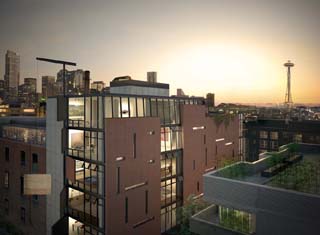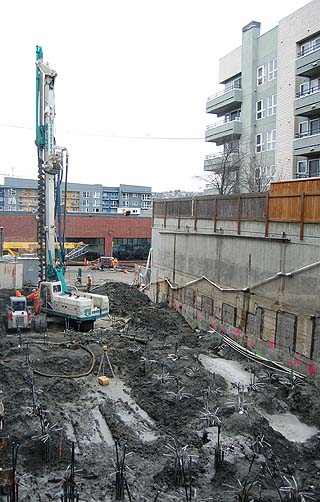January 5, 2010
New developer starts its first project: Art Stable
Journal Staff Reporter
A new development company called Point32 has started work on its first project: a seven-story loft building called Art Stable in South Lake Union that was designed by Tom Kundig.
Art Stable is at 516 Yale Ave. N. It will have 2,000 square feet of retail on the ground floor, parking on the first floor that is accessible through the alley, and five single-floor lofts above. Four of the five units have sold. They range from 2,300 to 4,100 square feet and cost between $500 and $850 a square foot. Kundig is lead architect on the project for Olson Kundig Architects.
Chris Rogers, CEO of Point32, said the name Art Stable reflects the site's past and future. Historically, the site was used as a stable for horses but the project always has been conceived as a haven for artists. The original landowners had an art studio there and hoped to develop it eventually. Together, the owners and Point32 came up with the idea of creating a space geared toward creative people.
Units are designed for artists and people with large art collections. Walls on either end of the lofts open so large pieces or materials can be moved in or out of the building, through windows on the west side and metal doors on the east side, facing the alley. Interior build-outs will be chosen by individual buyers, who can also decide where they want windows.
Seattle has a tradition of live/work units and lofts, but Rogers said this is the first building he knows of that focuses on artists. Two of the buyers have said they plan to use their space to house collections in an open gallery format.
“This is an innovation that doesn't yet exist in Seattle,” Rogers said, “and I don't know whether it exists in other cities.”
Work began in October of 2009 and should be complete in September.
Geothermal heat
The steel and concrete building is not going for LEED certification but it has a number of sustainable features. One is an innovative technique that combines the 70 structural piles with a geothermal heat pump system.
Paul Schwer, president of mechanical engineer PAE Consulting Engineers, said the method has been used several times in Europe but not in the U.S.
High density polyethylene pipes for a geothermal heat pump system will run in loops through the auger-cast structural pilings of the building's foundation. Water will be pumped through the pipes, drawing heat from the surrounding earth in winter to warm the building. In the summer, excess heat from the building will be expelled into the earth through the same process.
Geothermal wells typically run 300 feet deep, but because of the area's high water table, the wells are only 50 feet below ground. When combined with an in-floor radiant heating and cooling system, Point32 expects to save between 30 percent and 50 percent on heating the building.
Drilling geothermal wells can add months to a project schedule. But unlike institutions or schools, commercial projects often don't have any time to spare. Putting the geothermal system into the structural piles, which were already necessary, added no time and made the system financially viable.
“If it wasn't for that combined piece, we wouldn't have been able to afford a geothermal system on this building,” Schwer said.
The system cost an additional $150,000, an investment Rogers said was worthwhile to set the building apart.
Another sustainable feature is flexibility. Buildings are generally built to last for 50 years but often get torn down much earlier. Rogers said that creates waste and generates a lot of upfront costs. Art Stable is designed to be converted to another use, such as office space, if the need arises. Ceilings in housing are generally too low for office space, but the ceilings in Art Stable are more than 12 feet high.
Rogers said this takes the recent trend of turning old warehouse space into condos and reverses it. He said the goal should be to “build our buildings to last 100, 150 years or longer, and to design them with enough flexibility than in fact, they could be repurposed over time.”
The building is naturally ventilated, though owners can install air conditioning systems if they choose. There is a focus on daylight to minimize the need for electric lighting.
Point32
Point32 is a new company but it already has some big projects, such as The Bullitt Foundation's proposed “living building” headquarters and renovation of the Belroy Apartments.
The company was founded in 2007 to develop urban infill projects that improve their surroundings. “We're really looking for sites and opportunities to create quality buildings but also, to have a contributory value beyond the development itself,” Rogers said.
There are four partners — Rogers, COO Chris Faul, Matt Kellogg and Jim Dow — and they have diverse backgrounds. Rogers was a project manager for the Seattle Art Museum, Faul has a structural engineering background, Kellogg has a history of real estate investment and business development, and Dow is managing partner of Schucart/Dow construction.
Having different skill sets means everyone brings something different to the table, Rogers said. All team members work on all projects.
Though the firm is doing well, Rogers said the recession has affected Point32. Because of the downturn, Art Stable broke ground a year later than planned. Luckily, he said the team had never intended it as a speculative project. Point32 had planned to move forward once it secured a fourth buyer, which it did last summer.
Other team members include Exxel Pacific, general contractor; PAE Consulting Engineers, mechanical engineer; DCI, structural engineer; Coughlin Porter Lundeen, civil engineer; ZZA Terracon, geotechnical engineer; Hermanson, mechanical contractor; and Kulchin, foundation drilling.
Katie Zemtseff can be
reached by email or by phone
at (206) 622-8272.


